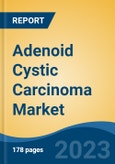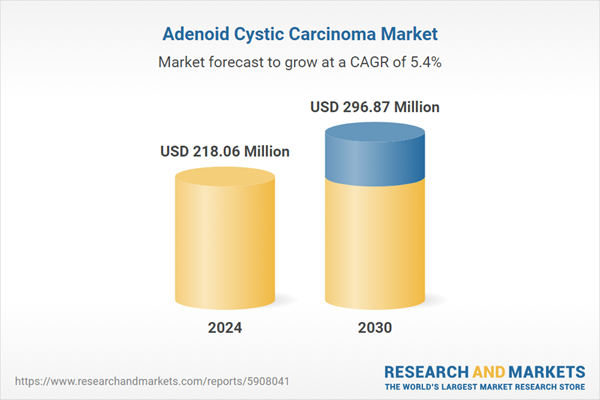Speak directly to the analyst to clarify any post sales queries you may have.
10% Free customizationThis report comes with 10% free customization, enabling you to add data that meets your specific business needs.
Key Market Drivers
Advancements in Precision Medicine
Advancements in Precision Medicine have emerged as a significant catalyst for the growth and transformation of the Global Adenoid Cystic Carcinoma (ACC) Market. Precision medicine represents a revolutionary approach to healthcare, particularly in the context of ACC, a rare and diverse cancer that has historically posed significant treatment challenges.This paradigm shift is primarily fueled by the recognition that each ACC patient's tumor has a unique molecular profile, demanding tailored therapeutic strategies. For instance, according to a 2024 article, immunohistochemical analysis of MYB expression is highly specific and sensitive for identifying the solid variant of adenoid cystic carcinoma of the breast among triple-negative breast cancers. This method offers a valuable diagnostic tool for distinguishing this rare cancer subtype from other triple-negative cases, as well.
Key Market Challenges
Limited Treatment Options
Adenoid Cystic Carcinoma (ACC), a rare and often aggressive cancer, poses significant challenges in terms of treatment options, which has been a persistent hindrance to progress in the Global Adenoid Cystic Carcinoma Market. While advancements have been made in recent years, the limited array of available therapies remains a primary concern for both patients and healthcare providers.Historically, surgery, radiation therapy, and chemotherapy have been the primary treatment modalities for ACC. However, these approaches often come with substantial drawbacks. Surgery, while effective for localized tumors, may not be feasible in cases where ACC has infiltrated critical structures or organs. Radiation therapy, though useful, can cause long-term side effects, and chemotherapy has shown limited efficacy against ACC, with a high potential for adverse reactions. The scarcity of treatment options has led to a pressing need for innovative and more effective therapies tailored specifically to ACC. Although targeted therapies and immunotherapies have shown promise in clinical trials, these treatments are still in their developmental stages and may not be accessible to all ACC patients.
Key Market Trends
Biomarker-Driven Approaches
Biomarker-driven approaches are playing a pivotal role in boosting the Global Adenoid Cystic Carcinoma (ACC) Market. ACC, a rare and heterogeneous cancer, has long presented challenges in terms of treatment personalization due to its varied genetic subtypes and clinical behaviors. However, the emergence of biomarker-driven approaches has ushered in a new era of precision medicine, offering tailored treatments that are transforming the landscape of ACC management.The essence of biomarker-driven approaches lies in the identification of specific biological markers or genetic signatures within an individual patient's tumor. These markers serve as indicators of the tumor's molecular characteristics, helping healthcare providers make informed decisions about the most suitable treatment regimen. In the case of ACC, where tumor heterogeneity is pronounced, this level of precision is paramount.
One of the notable biomarkers in ACC is the MYB-NFIB fusion gene, which is a common genetic alteration found in a subset of ACC cases. Identifying this fusion gene allows clinicians to categorize the tumor accurately and select therapies that align with its unique genetic profile. For example, targeted therapies designed to disrupt the MYB pathway have shown remarkable promise in clinical trials for ACC patients with this specific biomarker.
Key Market Players
- Ayala Pharmaceuticals
- Amgen Inc.
- CureVac AG
- Elevar Therapeutics
- Actuate Therapeutics
- Prelude Therapeutics
- Merck Sharp & Dohme Corp.
- Elly Lilly and Company
- Celgene Corporation
- OncoMed Pharmaceuticals
Report Scope:
In this report, the Global Adenoid Cystic Carcinoma Market has been segmented into the following categories, in addition to the industry trends which have also been detailed below:Adenoid Cystic Carcinoma Market, By Drug Class:
- Cytotoxic Drugs
- Tyrosine Kinase Inhibitors
- Monoclonal Antibodies
- Others
Adenoid Cystic Carcinoma Market, By Treatment:
- Surgery
- Radiation Therapy
- Chemotherapy
- Targeted Therapy
Adenoid Cystic Carcinoma Market, By Distribution Channel:
- Hospital Pharmacies
- Retail Pharmacies
- Online Pharmacies
Adenoid Cystic Carcinoma Market, By Region:
- North America
- United States
- Canada
- Mexico
- Europe
- France
- United Kingdom
- Italy
- Germany
- Spain
- Asia-Pacific
- China
- India
- Japan
- Australia
- South Korea
- South America
- Brazil
- Argentina
- Colombia
- Middle East & Africa
- South Africa
- Saudi Arabia
- UAE
- Egypt
Competitive Landscape
Company Profiles: Detailed analysis of the major companies present in the Global Adenoid Cystic Carcinoma Market.Available Customizations:
With the given market data, the publisher offers customizations according to a company's specific needs. The following customization options are available for the report.Company Information
- Detailed analysis and profiling of additional market players (up to five).
This product will be delivered within 1-3 business days.
Table of Contents
Companies Mentioned
- Ayala Pharmaceuticals
- Amgen Inc.
- CureVac AG
- Elevar Therapeutics
- Actuate Therapeutics
- Prelude Therapeutics
- Merck Sharp & Dohme Corp.
- Elly Lilly and Company
- Celgene Corporation
- OncoMed Pharmaceuticals
Table Information
| Report Attribute | Details |
|---|---|
| No. of Pages | 185 |
| Published | March 2025 |
| Forecast Period | 2024 - 2030 |
| Estimated Market Value ( USD | $ 218.06 Million |
| Forecasted Market Value ( USD | $ 296.87 Million |
| Compound Annual Growth Rate | 5.4% |
| Regions Covered | Global |
| No. of Companies Mentioned | 10 |









